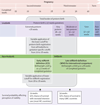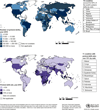Born too soon: the global epidemiology of 15 million preterm births
- PMID: 24625129
- PMCID: PMC3828585
- DOI: 10.1186/1742-4755-10-S1-S2
Born too soon: the global epidemiology of 15 million preterm births
Abstract
This second paper in the Born Too Soon supplement presents a review of the epidemiology of preterm birth, and its burden globally, including priorities for action to improve the data. Worldwide an estimated 11.1% of all livebirths in 2010 were born preterm (14.9 million babies born before 37 weeks of gestation), with preterm birth rates increasing in most countries with reliable trend data. Direct complications of preterm birth account for one million deaths each year, and preterm birth is a risk factor in over 50% of all neonatal deaths. In addition, preterm birth can result in a range of long-term complications in survivors, with the frequency and severity of adverse outcomes rising with decreasing gestational age and decreasing quality of care. The economic costs of preterm birth are large in terms of immediate neonatal intensive care, ongoing long-term complex health needs, as well as lost economic productivity. Preterm birth is a syndrome with a variety of causes and underlying factors usually divided into spontaneous and provider-initiated preterm births. Consistent recording of all pregnancy outcomes, including stillbirths, and standard application of preterm definitions is important in all settings to advance both the understanding and the monitoring of trends. Context specific innovative solutions to prevent preterm birth and hence reduce preterm birth rates all around the world are urgently needed. Strengthened data systems are required to adequately track trends in preterm birth rates and program effectiveness. These efforts must be coupled with action now to implement improved antenatal, obstetric and newborn care to increase survival and reduce disability amongst those born too soon.
Figures




References
-
- Liu L, Johnson H, Cousens S, Perin J, Scott S, Lawn J, Ruden I, Campbell H, Cibulskis R, Mengying L. et al. Global, regional and national causes of child mortality: an updated systematic analysis for 2010 with time trends since 2000. The Lancet. 2012;379:2151–2161. - PubMed
-
- Lawn JE, Cousens S, Zupan J. 4 million neonatal deaths: when? Where? Why? Lancet. 2005;365:891–900. - PubMed
-
- Lawn JE, Kerber K, Enweronu-Laryea C, Cousens S. 3.6 million neonatal deaths - what is progressing and what is not? Semin Perinatol. 2010;34:371–386. - PubMed
-
- Millennium Development Goals Indicators. http://mdgs.un.org/unsd/mdg/Default.aspx
Publication types
MeSH terms
LinkOut - more resources
Full Text Sources
Other Literature Sources
Medical

